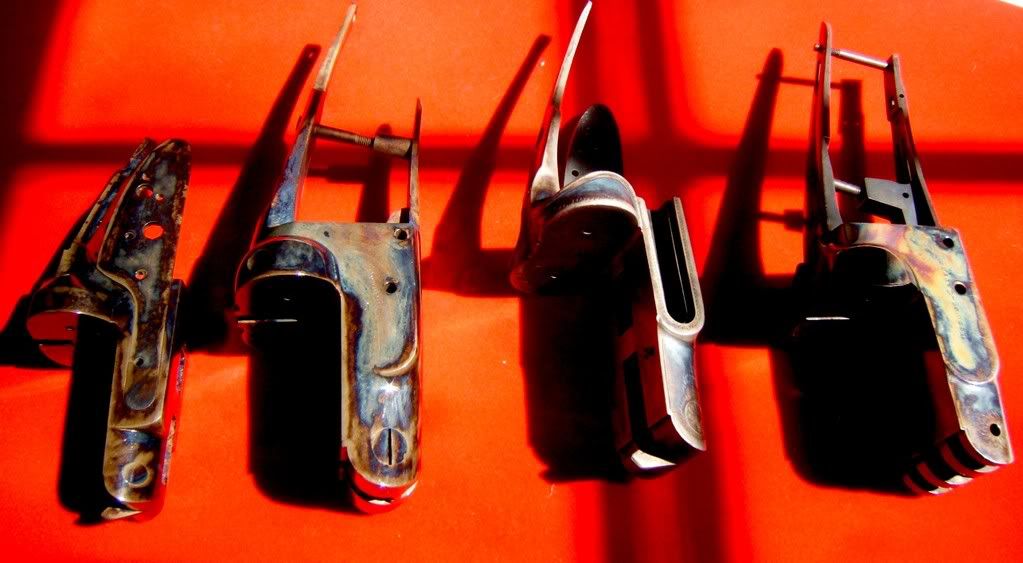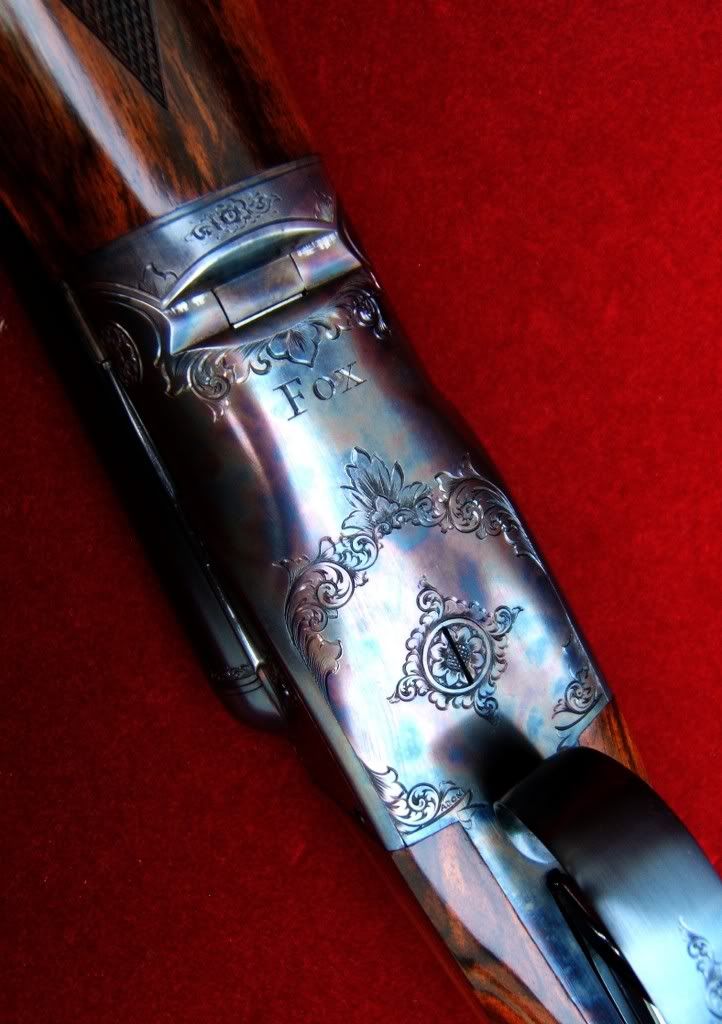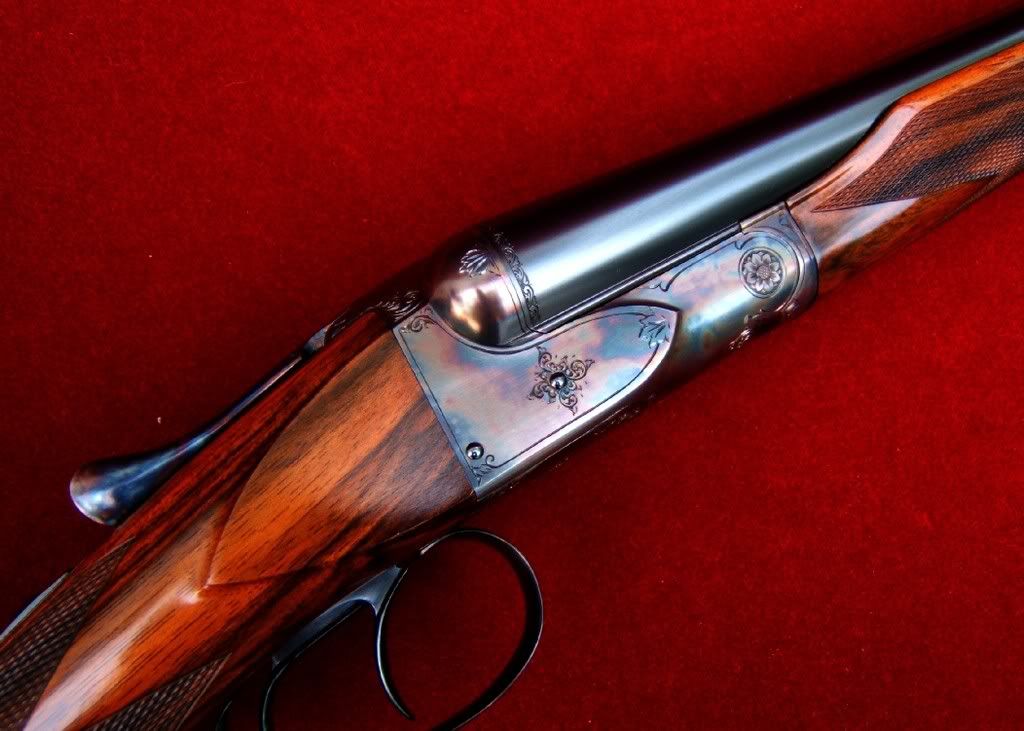|
S |
M |
T |
W |
T |
F |
S |
|
|
|
|
|
|
|
1
|
|
2
|
3
|
4
|
5
|
6
|
7
|
8
|
|
9
|
10
|
11
|
12
|
13
|
14
|
15
|
|
16
|
17
|
18
|
19
|
20
|
21
|
22
|
|
23
|
24
|
25
|
26
|
27
|
28
|
29
|
|
30
|
|
|
|
|
|
|
|
|
Forums10
Topics39,607
Posts563,352
Members14,600
| |
Most Online9,918
Jul 28th, 2025
|
|
|
|
Joined: Feb 2004
Posts: 132
Sidelock
|

Sidelock
Joined: Feb 2004
Posts: 132 |
400 degrees should be sufficient to temper the steel, 01 is commonly drawn to temperatures between 350-450 degrees and acheives a Rockwell hardness of around 60-63 at this range. I should clarify the time frame we use though. Since we typically are working with relatively small parts an hour at 400 is usually sufficient. Rule of thumb states that you should go one hour for each inch of maximum thickness of the part, I suppose a shotgun action would require 2-3 hours at that temp if you wanted to acheive the same effect. We have a Rockwell hardness testing machine in the lab, but casehardened surfaces are not that easy to check since the diamond just wants to break through the case into the softer section underneath. Comparison testing with a file definitely shows that the tempering operation softens the outer surface however. I still contend that its primary importance is for appearances though, it tends to bring out the colors and they always look better, in my opinion, after this operation.
You got nice colors on your action. I would suspect the plates you have help to contain the charcoal around the action during the quench, you get pretty much the same results with blocking. I've noticed, when using blocking, that the colors are generally better towards the side that the blocking plates are on. We use simliar methods for the parts we do in our lab, we have also had very good luck building fixtures that project out the bottom of the pack and enter the water first, I think this has the tendency to cause the water to be displaced and than it suddenly rushes in on the parts and creates very dramatic colors. Lots of possiblities with this process and it is always neat to see other peoples results.
Last edited by Alex Johnson; 09/11/08 08:33 PM.
|
|
|
|
|
Joined: Dec 2001
Posts: 12,743
Sidelock
|

Sidelock
Joined: Dec 2001
Posts: 12,743 |
I have absolutely no doubt whatsoever that the steel can be Colored at these lower tempertures. My only unresolved question at this time is "Is it desirable to re-color at the expense of the hardness". It has been pointed out & correctly so as far as I know, that at least most doubles which underwent proof did so "In the White". This would indicate they withstood proof without the benefit of the hardening. There are other considerations of course. Most seem to believe that from the beginning the primary purpose was for the Hardening & the coloring developed as a welcome, but secondary, factor. Consider for instance a 100+ yr old gun with ejectors which are set by being pushed in by rubbing down the breech face in closing. These 100 yrs & several thousands of times having been fired & closed would that breech face be in near so great condition had it not been "Glass Hard". I am not trying to belittle anyone elses choice or even sway opinion but trying to mull things over in my on mind & just perhaps throw out a little food for thought. As it stands right now though there are two things I don't want to happen. I don't want to send off one of my doubles & have
#1-Come back warped & with a poor fit
OR
#2-Have it come back significantly softer at the surface than it went off.
So far the risk of one or the other of these happening has just seemed to me to be too great, so I have decided to live with mine as they are.
Miller/TN
I Didn't Say Everything I Said, Yogi Berra
|
|
|
|
|
Joined: Aug 2004
Posts: 836 Likes: 21
Sidelock
|

Sidelock
Joined: Aug 2004
Posts: 836 Likes: 21 |
Here is a Sterlingworth I experiment with. Not exactly the right colors for a sterlingworth yet, so Ill re run it. Three runs so far (not counting the initial run it had at the factory) and NO warping, acceptable hardness, and the only thing Im not satisfied with is the colors yet.
Will, You should avoid having the wire touch the frame like aruond the lever and tang,..will spot your work and mess up your coverage Your colours are good but better suited to English guns or an LC very close to my picture below. last two pictures are my Fox/Parker colours which I believe to be very close to original CJ   
Last edited by C. J. Opacak; 09/12/08 12:19 PM.
The taste of poor quality lingers long after the cheap price is forgotten.........
|
|
|
|
|
Joined: Jan 2002
Posts: 2,307
Sidelock
|

Sidelock
Joined: Jan 2002
Posts: 2,307 |
Mr. Will, don't know if those colors are "right" for a Sterlingworth or not, but the colors look very nice. Hope you get your procedures worked out.
|
|
|
|
|
Joined: Nov 2005
Posts: 4,598
Sidelock
|

Sidelock
Joined: Nov 2005
Posts: 4,598 |
These are some stills captured from the Marlin DVD. Interesting bits of information. Receivers are loaded by layers  Charcoal is spread between each layer  They take the crucible to the line of furnaces.  Notice the uncovered crucible on the floor  After heating it is removed from the furnace  And dumped directly into the barrel of running water  Steam from the dump.  The receivers are captured in a basket  They are taken out  The water is turned off  Pete
|
|
|
|
|
Joined: Feb 2004
Posts: 132
Sidelock
|

Sidelock
Joined: Feb 2004
Posts: 132 |
My thoughts are that if air touches the parts before the quench it will spoil the colors and this line of thinking is not supported by the process that they show here. I personally believe that this video was more for show more and did not represent the true process that Marlin used to color case there actions.
|
|
|
|
|
Joined: Nov 2005
Posts: 4,598
Sidelock
|

Sidelock
Joined: Nov 2005
Posts: 4,598 |
Alex,
I agree. They spend more time on the company executives and making the stocks than on anything else. I also found it interesting that they say, "One of the methods used" and that the parts are in the furnace for "3 to 4 hours".
I think that is true in general for these early documentaries. They never reveal their entire process. Still the glimpses they do provide are educational.
I encourage any one interested to purchase this DVD from the source mentioned above. I found the images of forging the actions very interesting.
Pete
|
|
|
|
|
Joined: May 2004
Posts: 616 Likes: 1
Sidelock
|

Sidelock
Joined: May 2004
Posts: 616 Likes: 1 |
If any air comes into contact with the metal you will get an ugly grey scale. PeteM is right (thank you much for posting the photos by the way). Many older films and probably many of todays modern documentaries do not reveal the entire process simply because it wouldnt benefit them. I havent seen the film, but from the looks of the pictures he has that crucible right over top of the (flowing?) water. Then it looks like he practically plunges it in the water while simultaneously turning over? This would surely prevent any air from contacting the steel during the quench, as there appears to be no drop distance between the crucible and the water like many of us are doing, but Im not certain it would produce optimum colors. There is also the possibility that he placed a flat lid on top of everything and then re-covered it with charcoal, but who knows. Theres just something about that sh*t eatin grin on his face and how his bare hand is so close to the freshly remove 1000F+ crucible that still makes me wonder? 

|
|
|
|
|
Joined: Feb 2004
Posts: 132
Sidelock
|

Sidelock
Joined: Feb 2004
Posts: 132 |
It doesn't look like there is any cover on that crucible at all, just the color of burning charcoal. There was a guy on the Marlin forum that tried to reproduce this stunt and had his receivers come out scaled and grey (exactly what you would expect).
|
|
|
|
|
Joined: Nov 2005
Posts: 4,598
Sidelock
|

Sidelock
Joined: Nov 2005
Posts: 4,598 |
If any air comes into contact with the metal you will get an ugly grey scale. PeteM is right (thank you much for posting the photos by the way). Many older films and probably many of todays modern documentaries do not reveal the entire process simply because it wouldnt benefit them. I havent seen the film, but from the looks of the pictures he has that crucible right over top of the (flowing?) water. Then it looks like he practically plunges it in the water while simultaneously turning over? This would surely prevent any air from contacting the steel during the quench, as there appears to be no drop distance between the crucible and the water like many of us are doing, but Im not certain it would produce optimum colors. There is also the possibility that he placed a flat lid on top of everything and then re-covered it with charcoal, but who knows. Theres just something about that sh*t eatin grin on his face and how his bare hand is so close to the freshly remove 1000F+ crucible that still makes me wonder?  I have the software to "step frame by frame" through the film, which I did. He places an uncovered crucible in the furnace and you can see the black charcoal. He removes and carries it to the barrel with running water. He seemingly tips it directly into the water. As he does this, the internal of the crucible is not black, but a lighter grey tone than crucible. Is the charcoal glowing at this point?? Or did they switch crucibles during the filming and in fact there is a cover that fits internally. From the film you get the impression that he immediately pulls the strainer from the water and handles the receivers. Movie magic? Perhaps. I have images of the damascus makers handling very hot metal bare handed, so I can not be sure. What bothers me is they "fudge" the schedule by stating it as "three to four hours". I just don't buy that. I think they are hiding the particulars of the process. On the whole, I should state that the original film must have been in very bad condition. I am pretty sure they taped the original playing on a screen. This tape was eventually converted to DVD. So it is a third generation image product by my guess. Definition and framing are degraded. However, it is still worth watching. As it is the only historical record we have of an American gun making factory during this time period. I got a kick out of watching the workers going home at the end of the day. Pete
|
|
|
|
|